Enhancement of the Electrochemical Properties of an Open-Pore Graphite Foam with Electrochemically Reduced Graphene Oxide and Alternating Current Dispersed Platinum Particles
Abstract
1. Introduction
2. Materials and Methods
2.1. Chemicals
2.2. GFE Preparation
2.3. Electrochemical Measurements
2.4. Physical Measurements
3. Results and Discussion
3.1. Synthesis, FESEM, and EDX Analysis
3.1.1. RGO Synthesis
3.1.2. Pt Particle
3.2. Electrochemical Characterization
3.2.1. GFE/RGO
3.2.2. Pt-Modified Electrodes
3.3. Physical Characterization
3.3.1. Nitrogen Adsorption Isotherms
3.3.2. Permeability and Pressure Drop Measurements
4. Conclusions
Author Contributions
Funding
Acknowledgments
Conflicts of Interest
References
- Prieto, R.; Louis, E.; Molina, J.M. Fabrication of mesophase pitch-derived open-pore carbon foams by replication processing. Carbon 2012, 50, 1904–1912. [Google Scholar] [CrossRef]
- Molina, J.M. Mesophase pitch-derived graphite foams with selective distribution of TiC submicron particles for catalytic applications. Carbon 2016, 103, 5–8. [Google Scholar] [CrossRef]
- Lai, J.; Nsabimana, A.; Luque, R.; Xu, G. 3D Porous carbonaceous electrodes for electrocatalytic applications. Joule 2018, 2, 76–93. [Google Scholar] [CrossRef]
- Morozov, S.V.; Novoselov, K.S.; Katsnelson, M.I.; Schedin, F.; Elias, D.C.; Jaszczak, J.A.; Geim, A.K. Giant intrinsic carrier mobilities in graphene and its bilayer. Phys. Rev. Lett. 2008, 100, 016602. [Google Scholar] [CrossRef]
- Singh, V.; Joung, D.; Zhai, L.; Das, S.; Khondaker, S.I.; Seal, S. Graphene based materials: Past present and future. Prog. Mater. Sci. 2011, 56, 1178–1271. [Google Scholar] [CrossRef]
- Shinde, D.B.; Vishal, V.M.; Kurungot, S.; Pillai, V.K. Electrochemical preparation of nitrogen-doped graphene quantum dots and their size-dependent electrocatalytic activity for oxygen reduction. Bull. Mater. Sci. 2015, 38, 435–442. [Google Scholar] [CrossRef]
- Mitra, S.; Banerjee, S.; Datta, A.; Chakravorty, D. A brief review on graphene/inorganic nanostructure composites: Materials for the future. Indian J. Phys. 2016, 90, 1019–1032. [Google Scholar] [CrossRef]
- Kauppila, J.; Kunnas, P.; Damlin, P.; Viinikanoja, A.; Kvarnström, C. Electrochemical reduction of graphene oxide films in aqueous and organic solutions. Electrochim. Acta 2013, 89, 84–89. [Google Scholar] [CrossRef]
- Chen, L.; Tang, Y.; Wang, K.; Liu, C.; Luo, S. Direct electrodeposition of reduced graphene oxide on glassy carbon electrode and its electrochemical application. Electrochem. Commun. 2011, 13, 133–137. [Google Scholar] [CrossRef]
- Hilder, M.; Winther-Jensen, B.; Li, D.; Forsyth, M.; MacFarlane, D.R. Direct electro-deposition of graphene from aqueous suspensions. Phys. Chem. Chem. Phys. 2011, 13, 9187–9193. [Google Scholar] [CrossRef]
- Zhou, M.; Wang, Y.; Zhai, Y.; Zhai, J.; Ren, W.; Wang, F.; Dong, S. Controlled synthesis of large-area and patterned electrochemically reduced graphene oxide film. Chem. Eur. J. 2009, 15, 6116–6120. [Google Scholar] [CrossRef] [PubMed]
- Bonanni, A.; Pumera, M. Electroactivity of graphene oxide on different substrates. R. Soc. Chem. Adv. 2012, 2, 10575–10578. [Google Scholar] [CrossRef]
- Zhong, M.; Song, Y.; Li, Y.; Ma, C.; Zhai, X.; Shi, J.; Guo, Q.; Liu, L. Effect of reduced graphene oxide on the properties of an activated carbon cloth/polyaniline flexible electrode for supercapacitors application. J. Power Sources 2012, 217, 6–12. [Google Scholar] [CrossRef]
- Yoo, E.; Okata, T.; Akita, T.; Kohyama, M.; Nakamura, J.; Honna, I. Enhanced electrocatalytic activity of Pt subnanoclusters on graphene nanosheet surface. Nano Lett. 2009, 9, 2255–2259. [Google Scholar] [CrossRef]
- Kundu, P.; Nethravathi, C.; Deshpande, P.A.; Rajamathi, M.; Madras, G.; Ravishankar, N. Ultrafast microwave-assisted route to surfactant-free ultrafine Pt nanoparticles on graphene: Synergistic co-reduction mechanism and high catalytic activity. Chem. Mater. 2011, 23, 2772–2780. [Google Scholar] [CrossRef]
- Xin, Y.; Liu, J.; Zhou, Y.; Liu, W.; Gao, J.; Xie, Y.; Yin, Y.; Zou, Z. Preparation and characterization of Pt supported on graphene with enhanced electrocatalytic activity in fuel cell. J. Power Sources 2011, 196, 1012–1018. [Google Scholar] [CrossRef]
- Zhang, Y.; Liu, C.; Min, Y.; Qi, X.; Ben, X. The simple preparation of graphene/Pt nanoparticles composites and their electrochemical performance. J. Mater. Sci. Mater. Electron. 2013, 24, 3244–3248. [Google Scholar] [CrossRef]
- Er, E.; Çelikkan, H.; Erk, N. A novel electrochemical nano-platform based on graphene/platinum nanoparticles/nafion composites for the electrochemical sensing of metoprolol. Sens. Actuator B Chem. 2017, 238, 779–787. [Google Scholar] [CrossRef]
- Ding, Y.Y.; Zheng, H.Y.; Cheng, J.J.; Xu, H.; Sun, M.X.; Yan, G. Platinum supported on reduced graphene oxide as a catalyst for the electrochemical hydrogenation of soybean oils. Solid State Sci. 2019, 92, 46–52. [Google Scholar] [CrossRef]
- Ghanim, A.H.; Koonce, J.G.; Hasa, B.; Rassoolkhani, A.M.; Cheng, W.; Peate, D.W.; Lee, J.; Mubeen, S. Low-loading of Pt nanoparticles on 3D carbon foam support for highly active and stable hydrogen production. Front. Chem. 2018, 6, 523. [Google Scholar] [CrossRef]
- Lupu, S.; Lakard, B.; Hihn, J.-Y.; Dejeu, J. Novel in situ electrochemical deposition of platinum nanoparticles by sinusoïdal voltages on conducting polymer films. Synth. Met. 2012, 162, 193–198. [Google Scholar] [CrossRef]
- Molina, J.; Fernandez, J.; del Río, A.I.; Bonastre, J.; Cases, F. Synthesis of Pt particles on electrochemically reduced graphene oxide by potentiostatic and alternate current methods. Mater. Charact. 2014, 89, 56–68. [Google Scholar] [CrossRef]
- Products: Chemically Modified Graphene Oxide. Available online: https://www.nanoinnova.com/product/chemically-modified-go (accessed on 5 June 2020).
- Maiorano, L.P.; Molina, J.M. Challenging thermal management by incorporation of graphite into aluminium foams. Mater. Des. 2018, 158, 160–171. [Google Scholar] [CrossRef]
- Brunauer, E.T.S.; Deming, L.S.; Deming, W.E. On a theory of the van der Waals adsorption of gases. J. Am. Ceram. Soc. 1940, 62, 1723–1732. [Google Scholar] [CrossRef]
- Chen, K.; Chen, L.; Chen, Y.; Bai, H.; Li, L. Three-dimensional porous graphene-based composite materials: Electrochemical synthesis and application. J. Mater. Chem. 2012, 22, 20968–20976. [Google Scholar] [CrossRef]
- Stankovich, S.; Dikin, D.A.; Dommett, G.H.B.; Kohlhaas, K.M.; Zimney, E.J.; Stach, E.A.; Piner, R.D.; Nguyen, S.T.; Ruoff, R.S. Graphene based composite materials. Nature 2006, 442, 282–286. [Google Scholar] [CrossRef]
- Molina, J.; Fernandez, J.; del Río, A.I.; Bonastre, J.; Cases, F. Electrochemical characterization of reduced graphene oxide-coated polyester fabrics. Electrochim. Acta 2013, 93, 44–52. [Google Scholar] [CrossRef]
- Li, Y.; Jiang, Y.; Chem, M.; Liao, H.; Huang, R.; Zhou, Z.; Tian, N.; Chen, S.; Sun, S. (Supporting information for) Electrochemically shape-controlled synthesis of trapezohedral platinum nanocrystals with high electrocatalytic activity. Chem. Commun. 2012, 48, 9531–9533. [Google Scholar] [CrossRef]
- Domínguez, S.; Arias, J.; Berenguer, A.; Morallón, E.; Cazorla, D. Electrochemical deposition of platinum submicron particles on different carbon supports and conducting polymers. J. Appl. Electrochem. 2008, 38, 259–268. [Google Scholar] [CrossRef]
- Faulkner, L.R.; Bard, A.J. Electrochemical Methods: Fundamentals and Applications, 2nd ed.; Wiley: New York, NY, USA, 1980; p. 864. [Google Scholar]
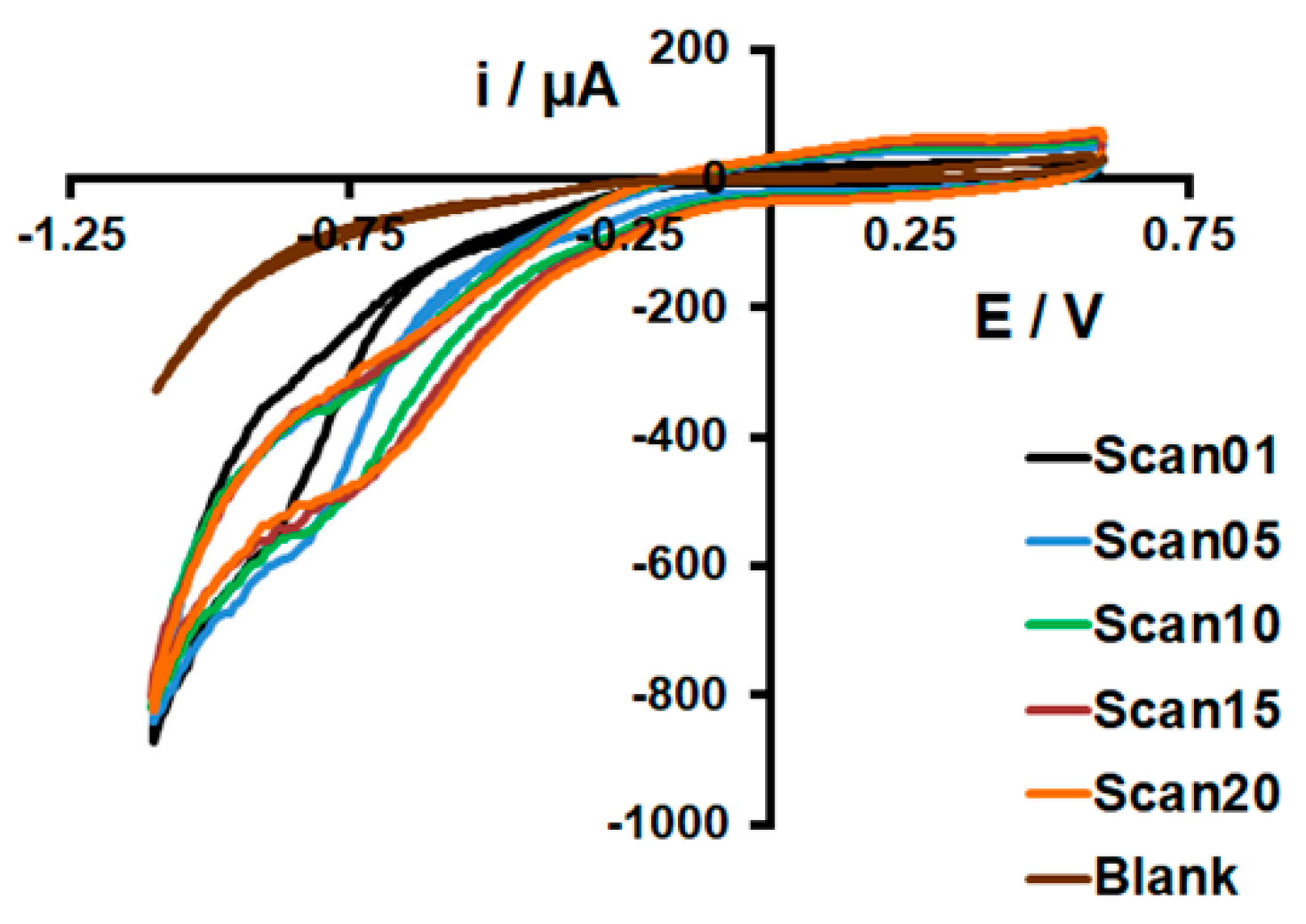
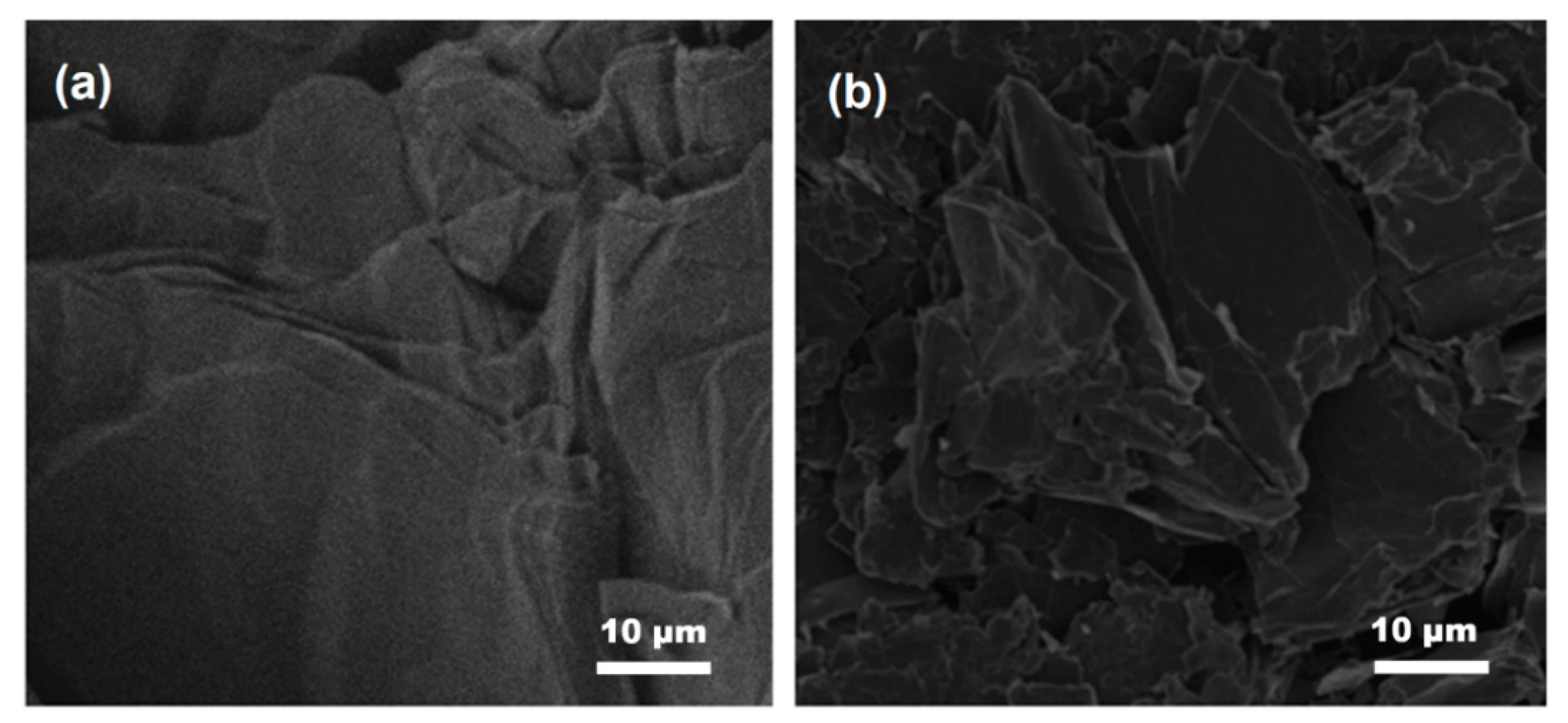
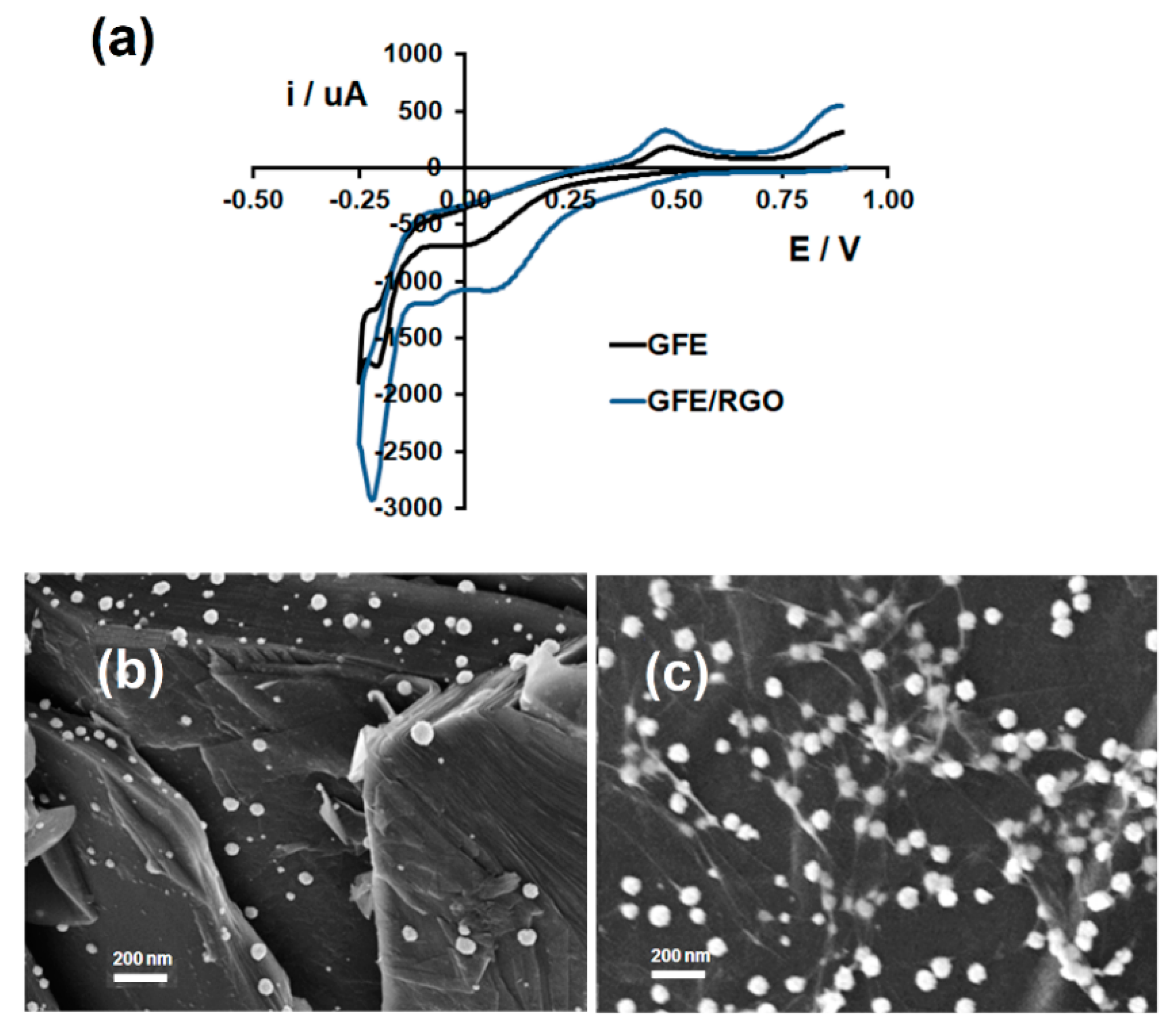
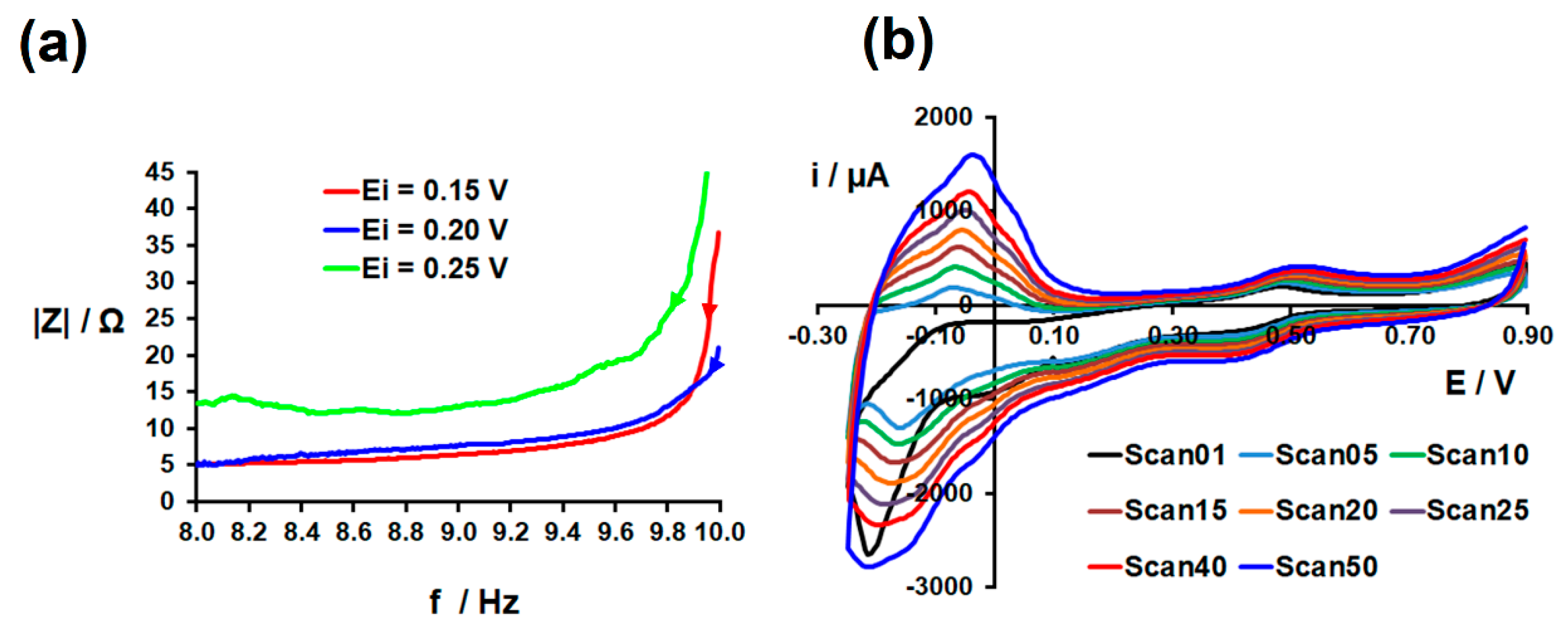
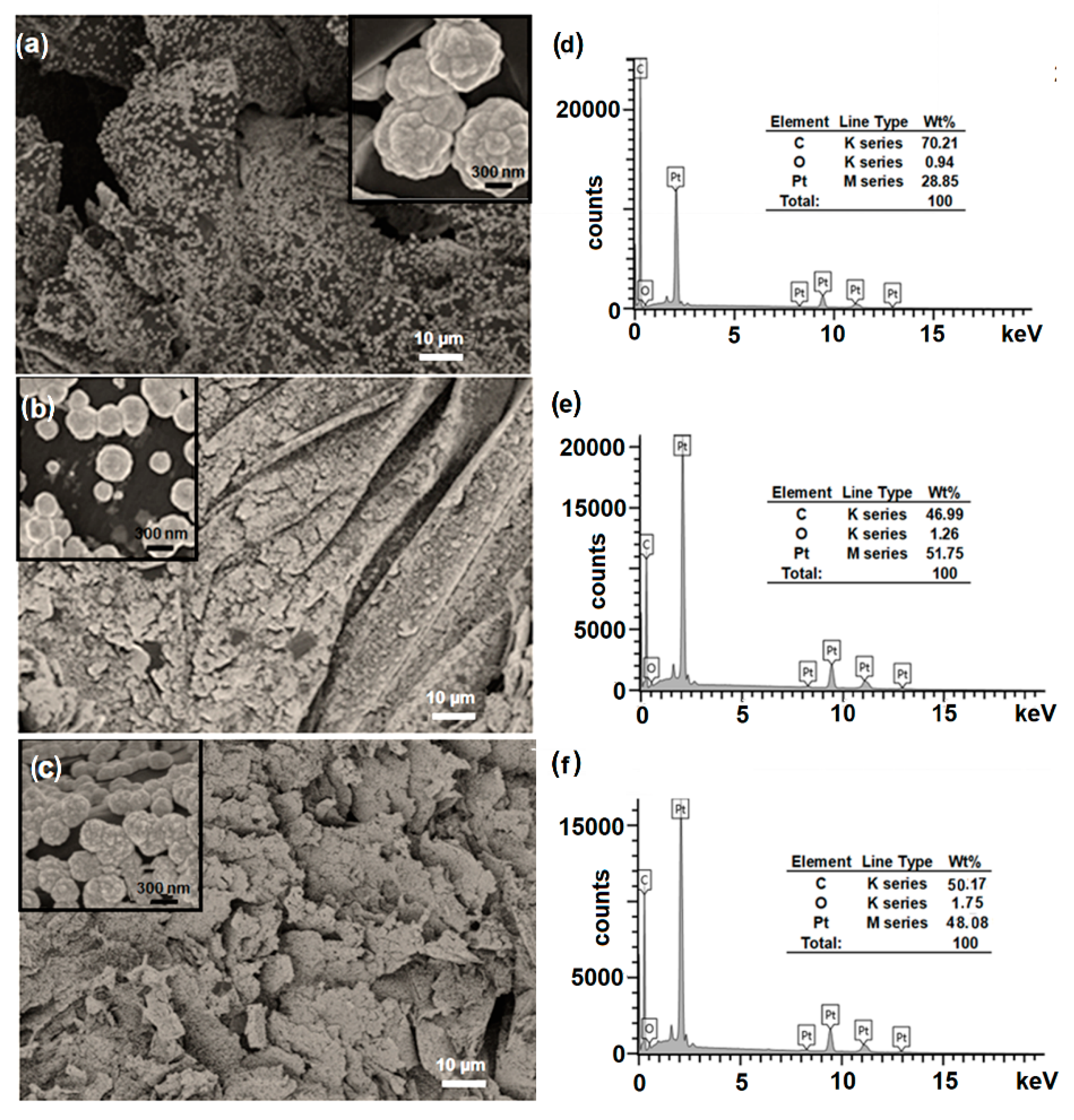
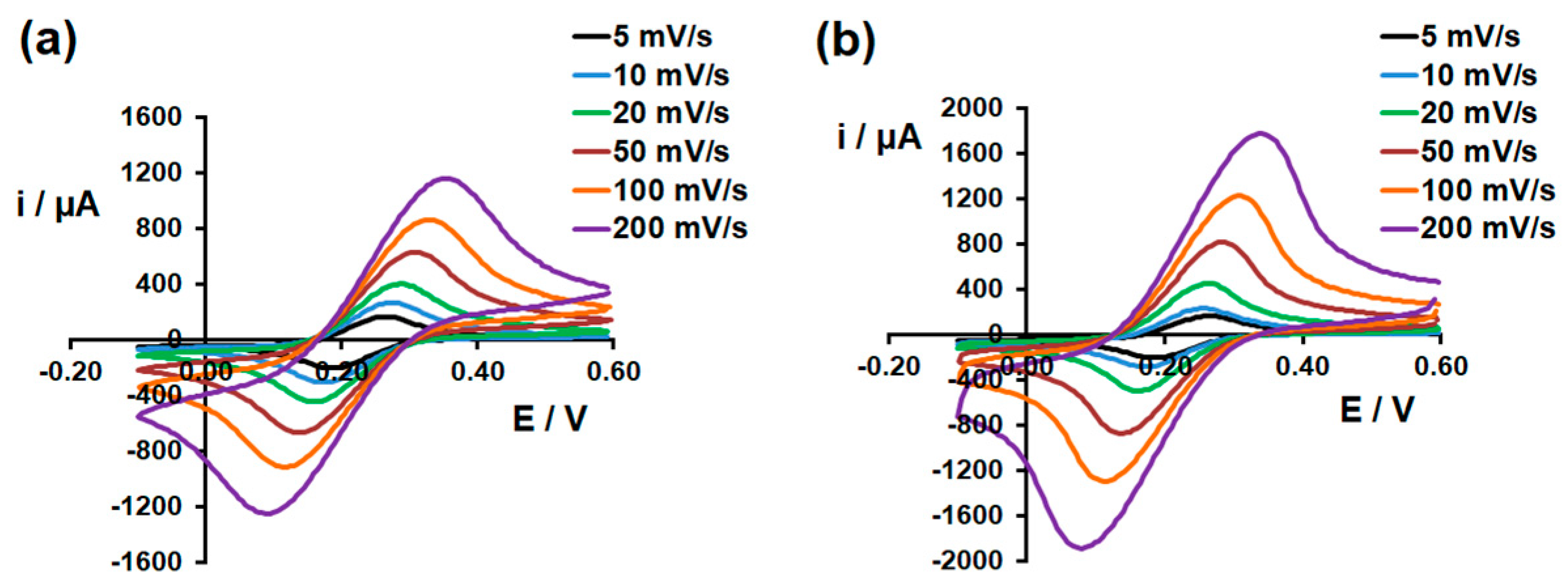
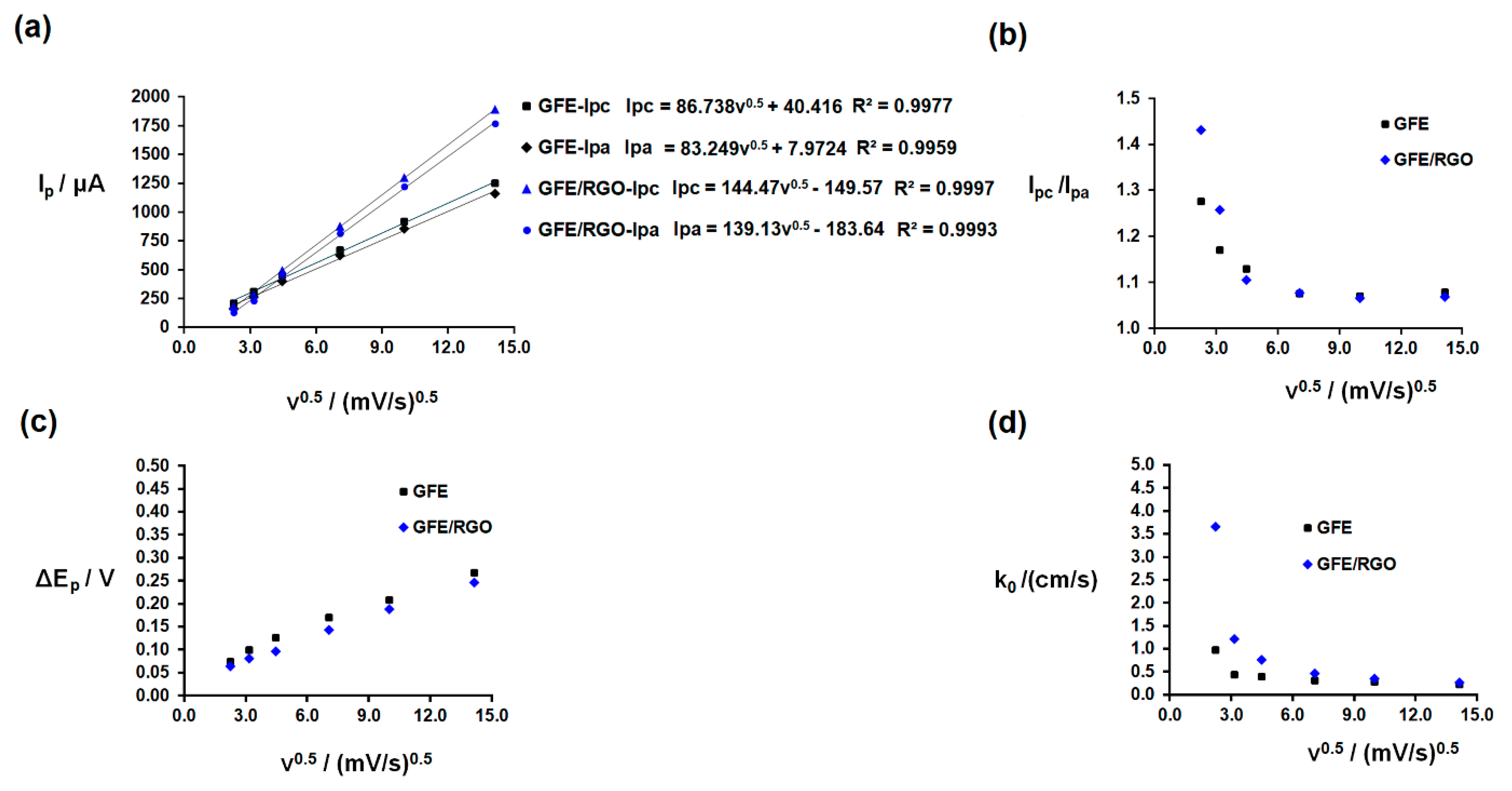
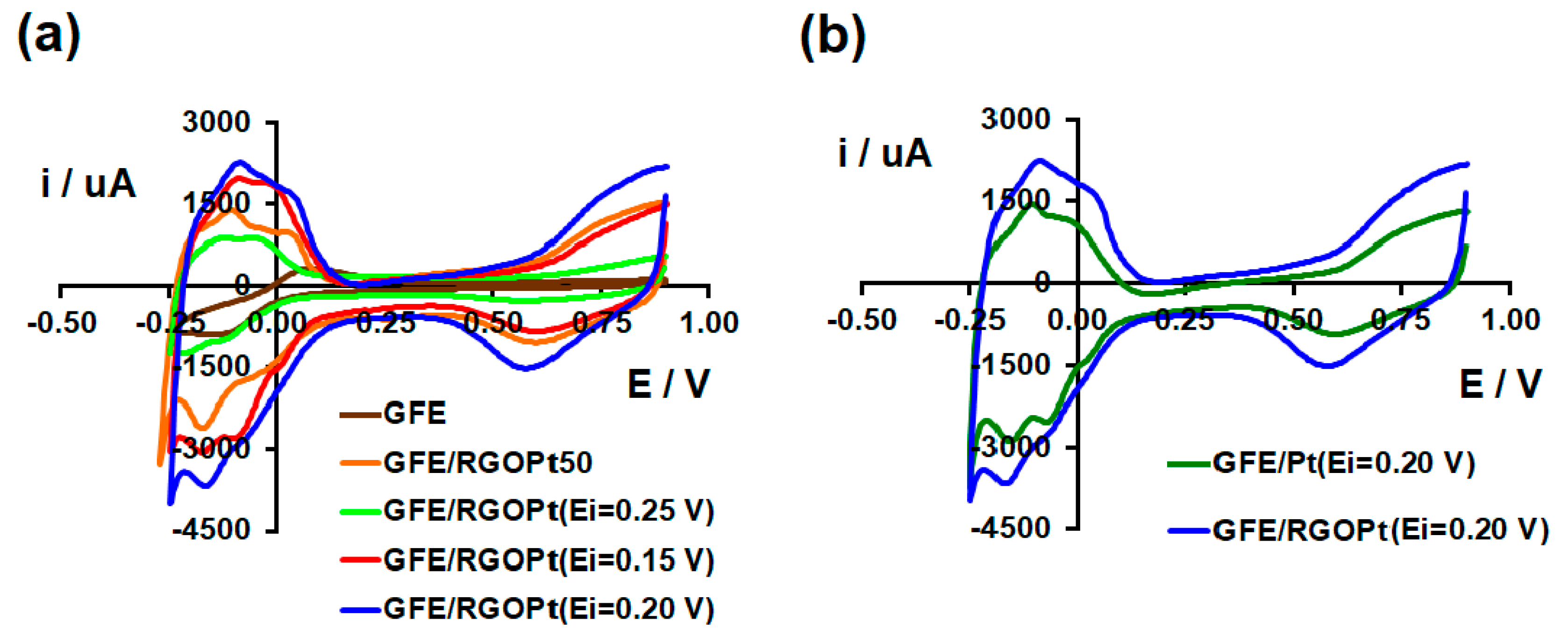
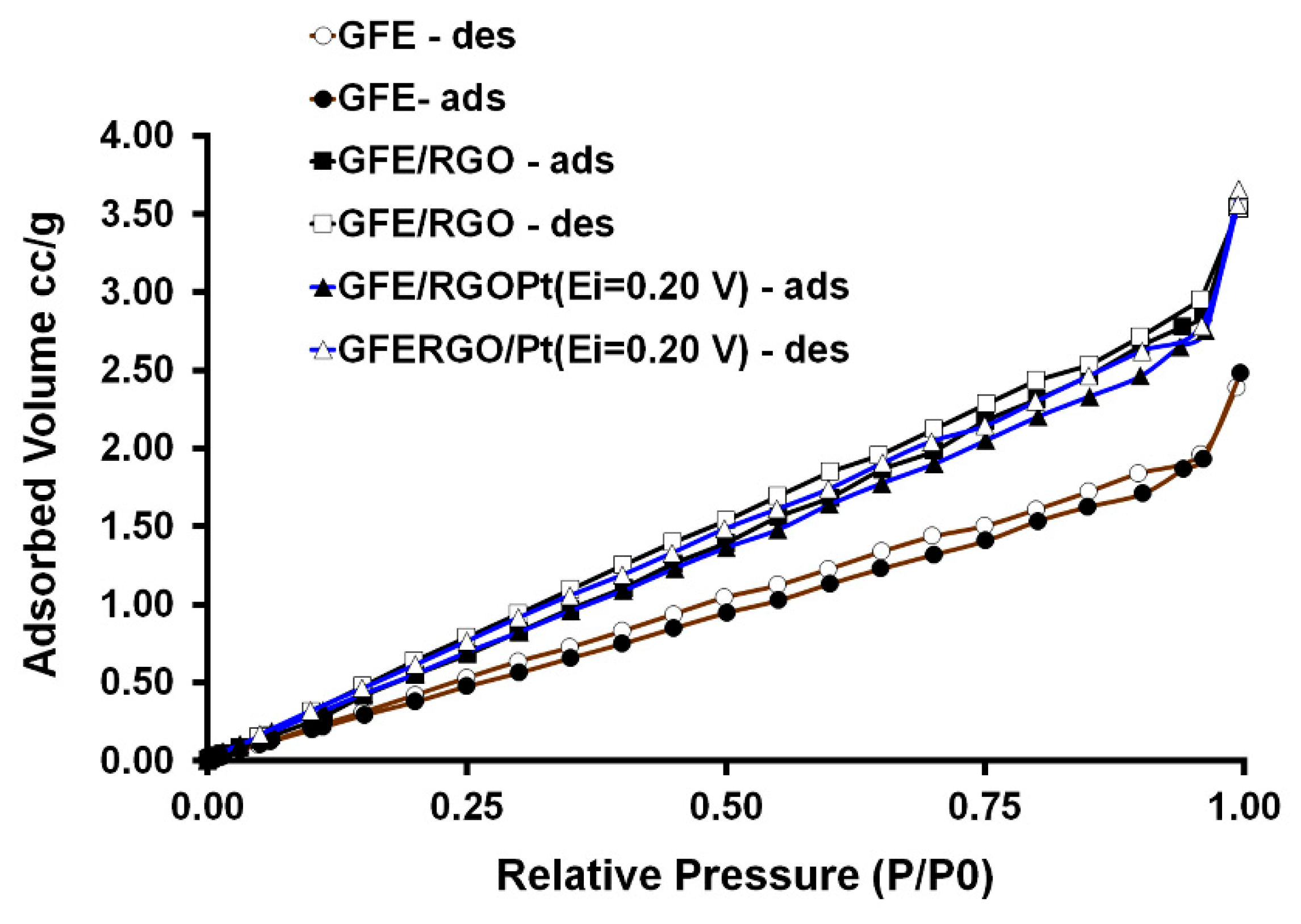
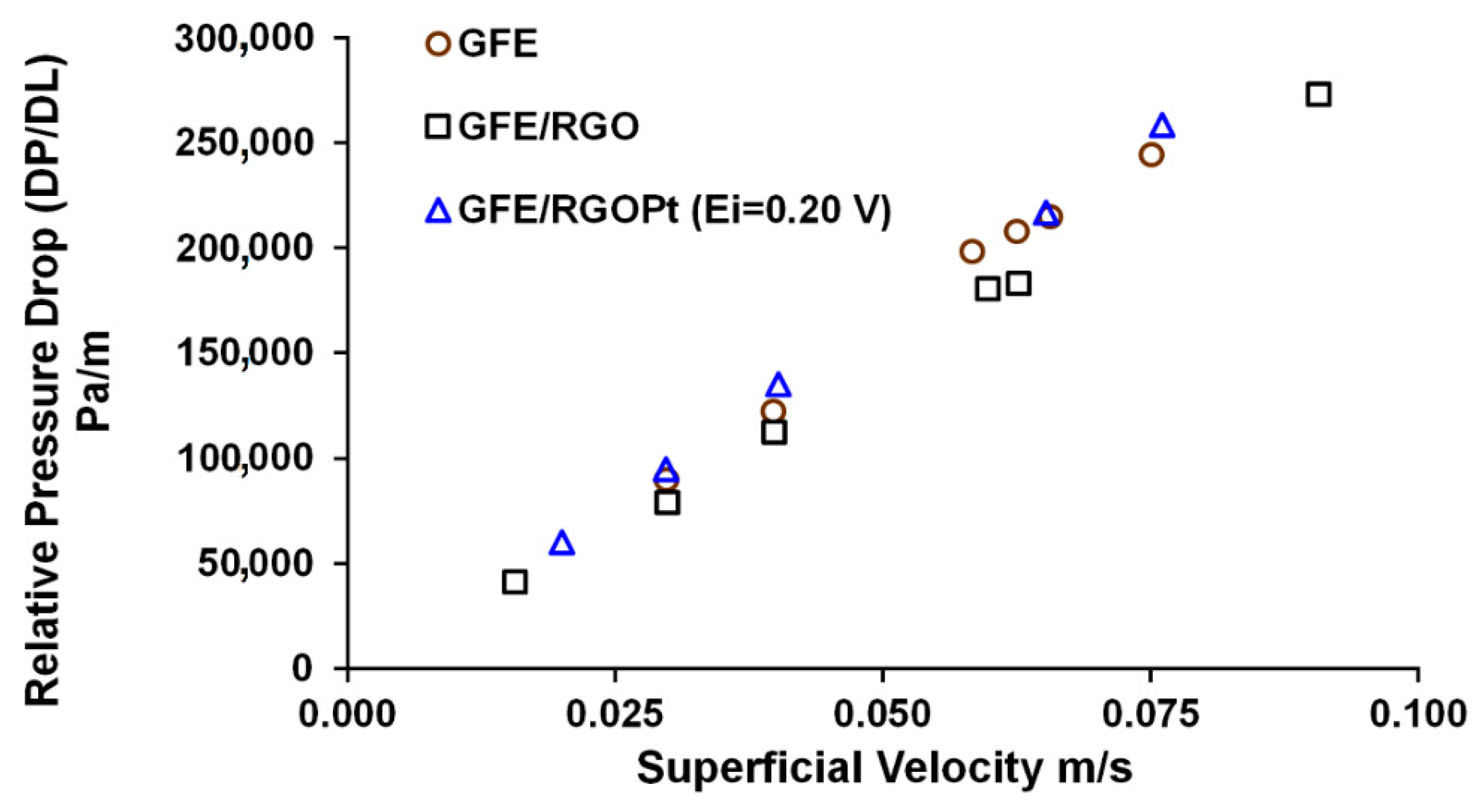
| Samples | Specific Surface Area (m2 g−1) | Micropore Volume (cm3 g−1) | Mesopore Volume (cm3 g−1) |
|---|---|---|---|
| GFE | 3.095 | 5.24 × 10−4 | 2.46 × 10−3 |
| GFE/RGO | 6.008 | 9.19 × 10−4 | 3.51 × 10−3 |
| GFE/RGOPt | 4.456 | 8.95 × 10−4 | 3.32 × 10−3 |
© 2020 by the authors. Licensee MDPI, Basel, Switzerland. This article is an open access article distributed under the terms and conditions of the Creative Commons Attribution (CC BY) license (http://creativecommons.org/licenses/by/4.0/).
Share and Cite
Fernández, J.; Bonastre, J.; Molina, J.M.; Cases, F. Enhancement of the Electrochemical Properties of an Open-Pore Graphite Foam with Electrochemically Reduced Graphene Oxide and Alternating Current Dispersed Platinum Particles. Coatings 2020, 10, 551. https://doi.org/10.3390/coatings10060551
Fernández J, Bonastre J, Molina JM, Cases F. Enhancement of the Electrochemical Properties of an Open-Pore Graphite Foam with Electrochemically Reduced Graphene Oxide and Alternating Current Dispersed Platinum Particles. Coatings. 2020; 10(6):551. https://doi.org/10.3390/coatings10060551
Chicago/Turabian StyleFernández, Javier, José Bonastre, José Miguel Molina, and Francisco Cases. 2020. "Enhancement of the Electrochemical Properties of an Open-Pore Graphite Foam with Electrochemically Reduced Graphene Oxide and Alternating Current Dispersed Platinum Particles" Coatings 10, no. 6: 551. https://doi.org/10.3390/coatings10060551
APA StyleFernández, J., Bonastre, J., Molina, J. M., & Cases, F. (2020). Enhancement of the Electrochemical Properties of an Open-Pore Graphite Foam with Electrochemically Reduced Graphene Oxide and Alternating Current Dispersed Platinum Particles. Coatings, 10(6), 551. https://doi.org/10.3390/coatings10060551






